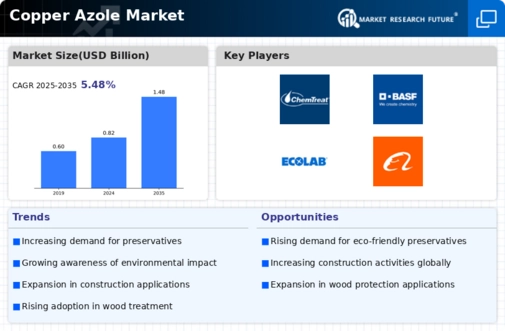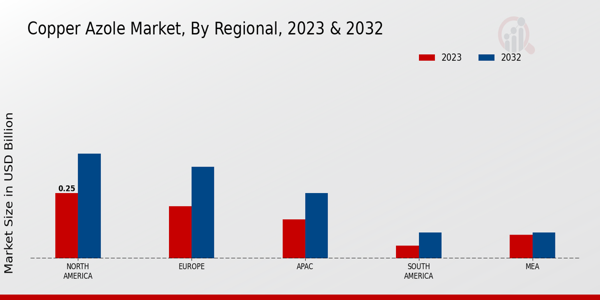Market Growth Projections
The Global Copper Azole Market Industry is projected to experience substantial growth over the next decade. With an estimated market value of 0.82 USD Billion in 2024, the industry is expected to expand significantly, reaching 1.48 USD Billion by 2035. This growth is underpinned by a compound annual growth rate (CAGR) of 5.49% from 2025 to 2035, indicating a robust demand for copper azole in various applications. The increasing focus on sustainable wood preservation solutions and regulatory support for eco-friendly products are likely to drive this upward trend, positioning copper azole as a key player in the wood treatment market.
Rising Construction Activities
The Global Copper Azole Market Industry benefits from the resurgence of construction activities worldwide. As urbanization accelerates and infrastructure projects expand, the demand for durable and long-lasting building materials rises. Copper azole, with its proven effectiveness in wood preservation, becomes a preferred choice among builders and contractors. The construction sector's growth is expected to drive the market, as more projects incorporate copper azole-treated wood to ensure longevity and resistance to environmental factors. This trend aligns with the projected CAGR of 5.49% from 2025 to 2035, indicating a robust future for the market as construction demands evolve.
Increasing Demand for Wood Preservation
The Global Copper Azole Market Industry experiences a notable surge in demand for wood preservation solutions. Copper azole, recognized for its efficacy in protecting wood against decay and insect damage, is increasingly favored in residential and commercial applications. The growing awareness of sustainable building practices further propels this trend, as copper azole is perceived as a more environmentally friendly alternative to traditional preservatives. In 2024, the market is valued at 0.82 USD Billion, reflecting the rising adoption of copper azole in various sectors, including construction and landscaping, which are vital for enhancing the longevity of wooden structures.
Technological Advancements in Production
Technological advancements in the production of copper azole are poised to enhance the efficiency and quality of the Global Copper Azole Market Industry. Innovations in manufacturing processes, such as improved synthesis techniques and better formulation methods, contribute to higher product performance and lower production costs. These advancements enable manufacturers to meet the increasing demand for high-quality wood preservatives while maintaining competitive pricing. As the industry evolves, the potential for enhanced product offerings may attract new market entrants, further stimulating growth. This dynamic environment suggests a promising outlook for the market as it adapts to technological changes.
Consumer Preference for Sustainable Products
Consumer preferences are shifting towards sustainable and environmentally friendly products, significantly influencing the Global Copper Azole Market Industry. As awareness of environmental issues grows, consumers increasingly seek wood treatment solutions that minimize ecological impact. Copper azole, being less harmful than traditional preservatives, aligns well with these preferences. This shift is evident in various sectors, including residential construction and landscaping, where sustainable practices are becoming standard. The market's growth trajectory reflects this trend, as manufacturers adapt their offerings to meet consumer demands for greener alternatives, thereby enhancing the overall appeal of copper azole.
Regulatory Support for Eco-Friendly Products
Regulatory frameworks across various regions increasingly favor eco-friendly products, significantly impacting the Global Copper Azole Market Industry. Governments are implementing stringent regulations to reduce the use of harmful chemicals in wood treatment processes. This regulatory support encourages manufacturers to adopt copper azole, which is less toxic compared to other preservatives. As a result, the market is likely to witness substantial growth, driven by the shift towards sustainable practices. The anticipated growth trajectory suggests that by 2035, the market could reach 1.48 USD Billion, indicating a robust response to regulatory incentives promoting environmentally responsible solutions.
















Leave a Comment